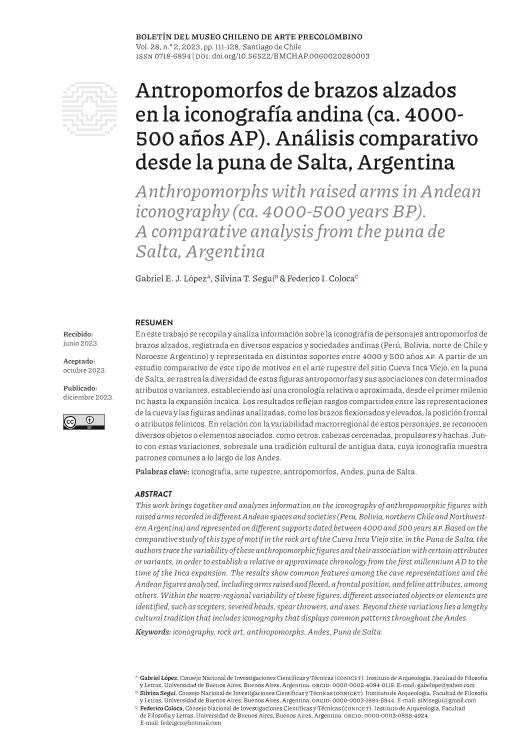Artículo
En este trabajo se recopila y analiza información sobre la iconografía de personajes antropomorfos de brazos alzados, registrada en diversos espacios y sociedades andinas (Perú, Bolivia, norte de Chile y Noroeste Argentino) y representada en distintos soportes entre 4000 y 500 años ap. A partir de un estudio comparativo de este tipo de motivos en el arte rupestre del sitio Cueva Inca Viejo, en la puna de Salta, se rastrea la diversidad de estas fi guras antropomorfas y sus asociaciones con determinados atributos o variantes, estableciendo así una cronología relativa o aproximada, desde el primer milenio dc hasta la expansión incaica. Los resultados refl ejan rasgos compartidos entre las representaciones de la cueva y las fi guras andinas analizadas, como los brazos fl exionados y elevados, la posición frontal o atributos felínicos. En relación con la variabilidad macrorregional de estos personajes, se reconocen diversos objetos o elementos asociados, como cetros, cabezas cercenadas, propulsores y hachas. Junto con estas variaciones, sobresale una tradición cultural de antigua data, cuya iconografía muestra patrones comunes a lo largo de los Andes. This work brings together and analyzes information on the iconography of anthropomorphic figures with raised arms recorded in different Andean spaces and societies (Peru, Bolivia, northern Chile and Northwestern Argentina) and represented on different supports dated between 4000 and 500 years bp. Based on the comparative study of this type of motif in the rock art of the Cueva Inca Viejo site, in the Puna de Salta, the authors trace the variability of these anthropomorphic figures and their association with certain attributes or variants, in order to establish a relative or approximate chronology from the first millennium AD to the time of the Inca expansion. The results show common features among the cave representations and the Andean figures analyzed, including arms raised and flexed, a frontal position, and feline attributes, among others. Within the macro-regional variability of these figures, different associated objects or elements are identified, such as scepters, severed heads, spear throwers, and axes. Beyond these variations lies a lengthy cultural tradition that includes iconography that displays common patterns throughout the Andes.
Antropomorfos de brazos alzados en la iconografía andina (ca. 4000- 500 años AP): Análisis comparativo desde la puna de Salta, Argentina
Título:
Anthropomorphs with raised arms in Andean iconography (ca. 4000-500 years BP): A comparative analysis from the puna de Salta, Argentina
Fecha de publicación:
12/2023
Editorial:
Museo Chileno de Arte Precolombino
Revista:
Boletín del Museo Chileno de Arte Precolombino
ISSN:
0718-6894
Idioma:
Español
Tipo de recurso:
Artículo publicado
Clasificación temática:
Resumen
Palabras clave:
ICONOGRAFÍA
,
ARTE RUPESTRE
,
ANTROPOMORFOS
,
ANDES
,
PUNA DE SALTA
Archivos asociados
Licencia
Identificadores
Colecciones
Articulos(SEDE CENTRAL)
Articulos de SEDE CENTRAL
Articulos de SEDE CENTRAL
Citación
Lopez, Gabriel Eduardo Jose; Seguí, Silvina Tatiana; Coloca, Federico Ignacio; Antropomorfos de brazos alzados en la iconografía andina (ca. 4000- 500 años AP): Análisis comparativo desde la puna de Salta, Argentina; Museo Chileno de Arte Precolombino; Boletín del Museo Chileno de Arte Precolombino; 28; 2; 12-2023; 111-128
Compartir




